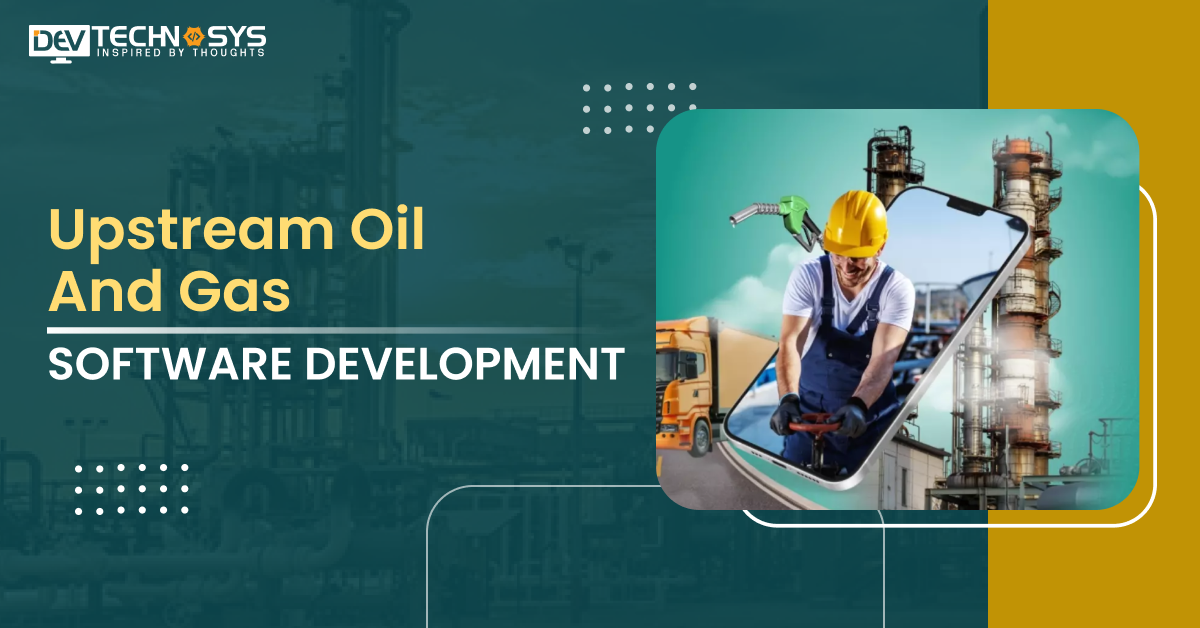Are you looking for upstream oil and gas software development? Developing upstream oil and gas software requires careful planning and a deep understanding of the industry’s complexities. As the backbone of the oil and gas sector, upstream operations involve exploration, drilling, and production—each requiring precise management and innovative technological solutions.
In today’s digital age, the demand for robust software that can streamline these processes has skyrocketed. From automating data collection and analysis to enhancing decision-making and operational efficiency, upstream oil and gas software plays a crucial role in optimizing the entire value chain.
This blog post will guide you through the essential steps involved in developing such software, offering insights into the key features, technologies, and best practices needed to create a solution that not only meets industry standards but also drives sustainable growth and competitive advantage.
What is Upstream Oil and Gas Software?
Upstream oil and gas software is specialized technology designed to manage and optimize the exploration, drilling, and production processes in the oil and gas industry. It streamlines operations such as geological surveys, reservoir modeling, well planning, and production monitoring.
This software enables companies to enhance decision-making by providing real-time data analysis, simulation capabilities, and project management tools. It also helps in mitigating risks, reducing costs, and improving efficiency by automating complex tasks and ensuring regulatory compliance. You can invest in upstream oil and gas software development by taking help from a custom software development company.
Future Predictions & Projections
- Deals to join and buy other companies worth about 58 billion U.S. dollars were reached in the first two months of 2024.
- About 87 M&A deals worth more than $100 million each were reported in the upstream market in 2023.

- Every year, the world makes more than 4 billion metric tons of oil. There are more than 50 percent of the world’s proven oil sources in the Middle East.
- In the 12 months before July 2024, the Chinese government-owned company made 441.79 billion U.S. dollars in sales.
Why Must You Develop Upstream Oil and Gas Software?
Upstream oil and gas software plays a crucial role in optimizing exploration, drilling, and production processes in the oil and gas industry. As the sector becomes increasingly complex, relying on traditional methods can lead to inefficiencies, increased costs, and potential risks.
As per the company that provide custom software development services in UAE, here’s why adopting upstream oil and gas software is essential:

1. Enhanced Data Management:
The software allows for the collection, storage, and analysis of vast amounts of data from various sources. This leads to better decision-making by providing real-time insights into reservoir performance, production rates, and equipment health.
2. Operational Efficiency:
By automating routine tasks such as monitoring, reporting, and compliance checks, upstream software reduces the workload on teams, allowing them to focus on critical operations. This automation minimizes errors and increases productivity.
3. Risk Mitigation:
The software provides predictive analytics, enabling companies to anticipate and mitigate risks before they impact operations. This proactive approach helps in reducing downtime and avoiding costly mistakes.
4. Cost Reduction:
Streamlining operations through software reduces operational costs by optimizing resource allocation, improving supply chain management, and enhancing maintenance planning. This leads to significant savings in the long run.
5. Regulatory Compliance:
Upstream oil and gas software helps ensure compliance with industry regulations and standards by automating documentation and reporting processes, reducing the risk of non-compliance penalties.
Steps of Upstream Oil and Gas Software Development
There are seven basic steps that make up the upstream oil and gas software development process. So, when you figure out how much it costs to build upstream oil and gas software, remember these steps.

Step 1: Looking at the Needs
Consult with partners and get clear requirements to figure out what you need for exploration, drilling, and production. In this first step, you make sure that your software fits the specific needs and challenges of the upstream oil and gas industry.
Step 2: Plan and Design
Hire on-demand developers to create a system design for upstream oil and gas software development. It allows for the integration, visualization, and analysis of data. Plan for security and scalability to make sure that your software can handle more data and keep you safe from possible dangers.
Step 3: Combining the Data
Sensors, historical databases, and real-time tracking systems are just some of the places where data can come from. Integrating these two systems is necessary to fully comprehend activities and, as a result, make better decisions.
Step 4: Develop the Software
Oil and gas software development companies set up basic features, such as synchronizing workflows, monitoring equipment, and using predictive analytics. To improve operational accuracy and speed, create modules for processing, displaying, and reporting data in real time.
Step 5: Test it Out
Carry out thorough tests to make sure the software works and is reliable in a range of situations. Make sure the software works well and safely by checking its security to stop data breaches and system failures.
Step 6: Final Release
Put the software into use in a controlled setting and give end users training and help. This step makes sure that the software is installed correctly and that users are ready to make the most of its features.
Step 7: Software Maintenance
Always keep an eye on how the system is working and ask users for comments. As needed, software updates and patches to meet practical needs and incorporate new technologies. This will keep the software up to date and working well.
Essential Features to Add in Upstream Oil and Gas Software Development
One of the best things about custom oil & gas software development services is that they let you improve operating efficiency and focus on the parts that need more attention. Some of the most important things you can include in your own upstream oil and gas features are:

i. Geological and Seismic Data Management
This feature lets you look at possible digging sites and decide if they are good candidates.
ii. Reservoir Simulation and Modeling
This feature lets you simulate how a reservoir would behave and see if it matches what you see. By using virtual models, companies can plan better ways to drill and lower the risks that might software do.
iii. Drilling and Well Management
This feature makes it easier to evaluate, plan, drill, and handle oil wells.
iv. Production Monitoring and Optimization
This feature lets companies look at production data to keep an eye on. How much oil is being produced in wells and use enhanced oil recovery techniques if the amount they get is low. This way, they can get the most out of their resources.
v. Asset Management and Maintenance
When you build an app like Rigzone, adding features helps keep track of and fix any problems. With drilling features, pipelines, and other physical assets that are used to get oil.
vi. Planning for money and resources
Some upstream oil and gas accounting software has this feature that can help you plan for money and resources for drilling activities.
vii. Supply Chain and Logistics Management
This feature is built into custom upstream software that helps companies keep the delivery system running smoothly. From production centers to refineries to distributors.
How Much Does It Cost to Make Upstream Oil and Gas Software?
Even though the cost of upstream oil and gas software development may be high at first, going digital will save money and time in the long run. We give a rough estimate of upstream oil and gas software development. The cost to create Upstream Oil and Gas software can be between $10000-$25000.
|
App complexity |
Cost (in USD) |
| Basic Upstream Oil and Gas Software |
$10000-$14000 |
|
Complex Upstream Oil and Gas Software |
$15000-$21000 |
| Highly Complex Upstream Oil and Gas Software |
$25000+ |
The cost to develop upstream oil and gas software can be broken down into several parts:
- Development Cost: The cost to build Upstream oil and gas software industry depends. The features, complexity, and number of connections that are added. So, the costs of making software are usually based on the size of the project, the technologies being used, and the skills to hire dedicated software developers in UAE.
- Training Costs: People who want to use new tools often have to pay extra for training. What makes the range different is the number of people, whether the training is done on-site or online, and how much training is needed.
- Costs of Implementation: implementation includes sending software and putting it together with other systems. These costs cover installing the software, setting it up to meet specific needs, and making sure it works with other systems.
- Costs of Testing: Testing is important to make sure that the program works right and meets all the standards. This includes testing for functionality, speed, and security.
- Extra Costs for Maintenance: Software maintenance costs for bug fixes, updates, and technical help usually run between 15% and 25% of the initial development cost per year.
Real-Life Examples of Upstream Oil and Gas Software Development
Here are some real-life examples of different businesses that harnessed the power of upstream oil and gas software development to transform their processes and see real results.

1. Shell – Predictive Maintenance
Using tools like Shell LubeAnalyst and Shell Remote Sense, Shell used advanced analytics and machine learning algorithms to figure out when equipment would break down.
Shell LubeAnalyst analyzes oil and uses 30 years of data to predict problems that might happen. Shell Remote Sense uses sensor technology and machine learning to give real-time information about the state of the oil. This method increases uptime, lowers repair costs by 5–10%, and improves operations by making decisions based on data.
2. British Petroleum – Reservoir Management
Artificial intelligence and data analytics were used by British Petroleum to improve the control of reservoirs. By combining different types of data, BP increased the rate of resource recovery and made their reserves last longer.
When AI and data analytics were used together, they gave British Petroleum useful information that helped them make better decision. The lower operational risks, and eventually lead to more sustainable resource management.
3. ExxonMobil – Production Optimization
Through its Catalysts and Licensing LLC, ExxonMobil made the InFocus Online Platform available to improve the way things are made. Advanced insights are used by this cloud-based system to improve plant performance, make operations more efficient, and cut down on production downtime. Users of oil & gas software development solutions UAE can make choices based on real-time data on the platform, which streamlines operations and boosts productivity.
4. Chevron – Safety Monitoring
Chevron Texaco set up an automated method for reporting health and safety issues. This system uses document scanning and TeleForm to get incident data from site inspection cards, store it, analyze it, and turn it into plans that can be put into action.
The system makes 15 predefined reports and updates Oracle database records so that staff working from abroad can easily view them. This switch to digital has cut down on the time needed to enter data by hand by a large amount. The given real-time insights, and improved the efficiency of safety tracking and making it easier to find and fix problems quickly.
5. TotalEnergies – Cloud Solutions for Flexibility
TotalEnergies SE is using cloud-based solutions to make its upstream processes more flexible and scalable. They are making the next wave of digital tools for the subsurface that will use AI to improve production and lower carbon intensity. On SLB’s Delfi digital platform, they are mainly working on digital solutions for geoscience modeling and reservoir engineering that happen below ground.
Final Thoughts
Upstream oil and gas software development requires careful planning, technical expertise, and a deep understanding of industry-specific needs. By following a structured approach, you can create a robust solution that enhances operational efficiency and decision-making.
To ensure the success of your project, it’s essential to hire software developers from an Upstream oil and Gas software company with experience in oil and gas software development. Their expertise will be invaluable in navigating the complexities and delivering a tailored solution that meets your business objectives.
FAQs
1. What do the upstream parts of the oil and gas business do?
Exploration and production work are examples of upstream functions in the oil and gas business. This includes drilling exploratory wells to look for oil and gas sources and getting crude oil and natural gas from underground reservoirs.
2. What are some common ways that upstream software is used in the oil and gas business?
Upstream oil and gas software is often used to look for possible oil and gas reserves, model how reservoirs behave for more in-depth evaluations. The plan drilling activities, keep track of oil and gas assets, and make logistics and shipping processes run more smoothly.
3. What are the most important ways that technology is used in the oil and gas business?
Some of the most important technical uses of upstream oil and gas software development are AI and machine learning for predictive maintenance. The Internet of Things (IoT) for real-time monitoring, and automated drilling systems for better extraction processes.
4. How much does upstream oil and gas software development cost?
The average cost of the upstream oil and gas software development industry can be anywhere from $10,000 to $25,000, depending on the level of complexity.
5. How long does oil and gas software development take?
A. The development of oil and gas software typically takes 3 to 8 months, depending on complexity, features, and customization needs. This timeline includes planning, design, development, testing, and deployment, ensuring a robust solution tailored to industry requirements.















